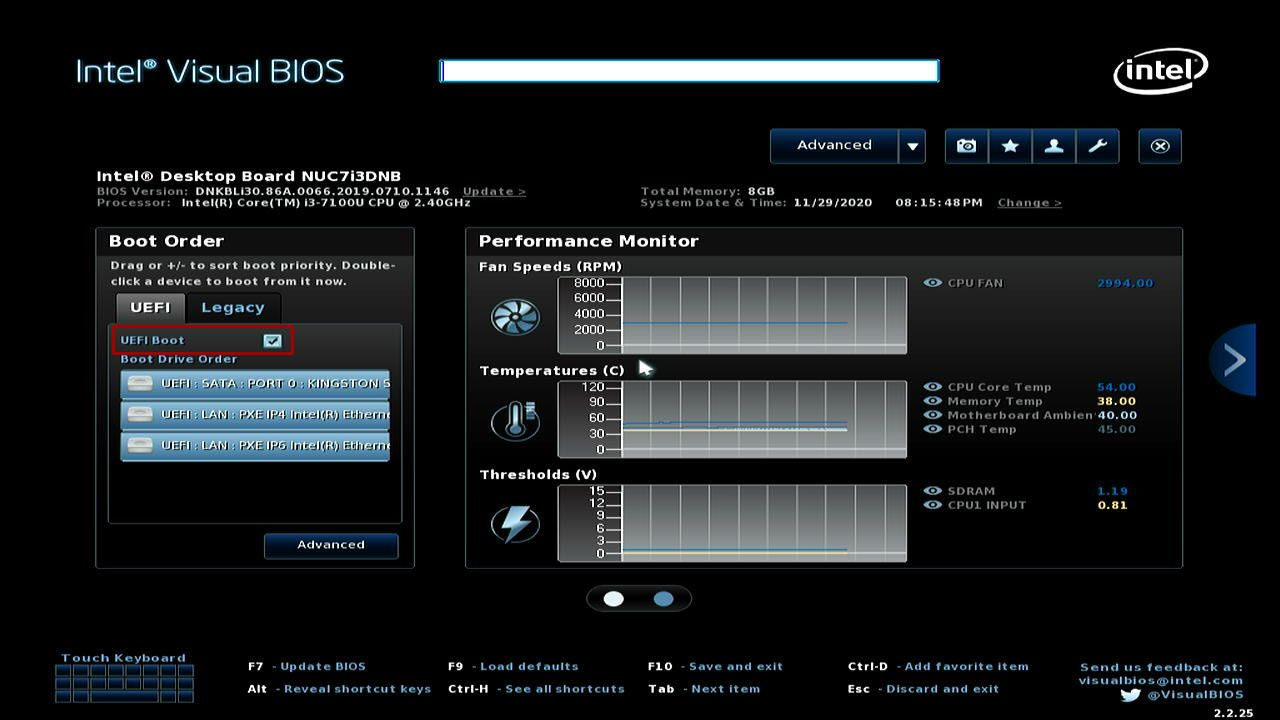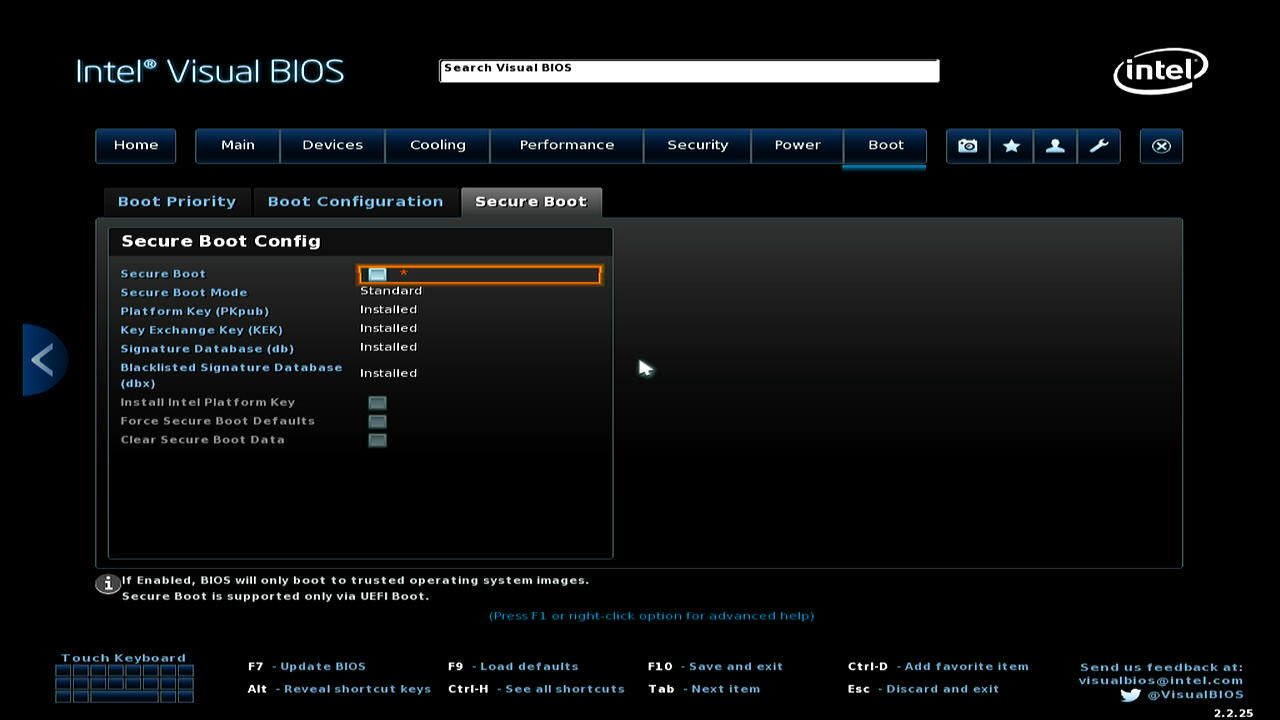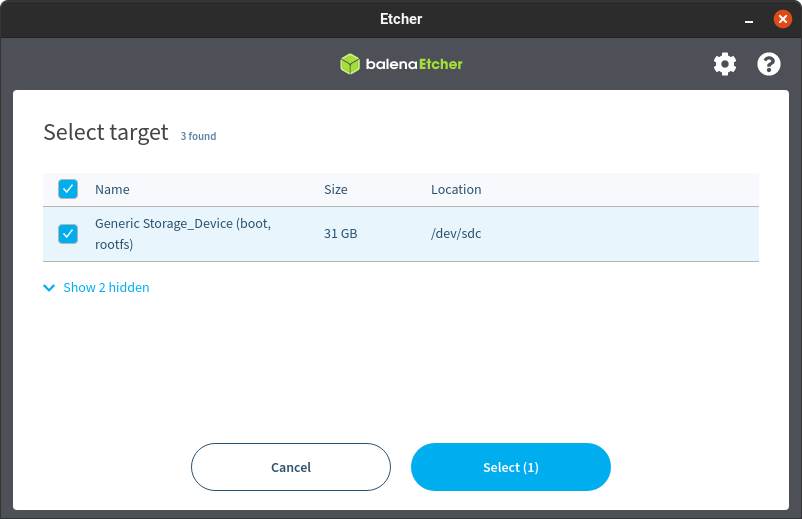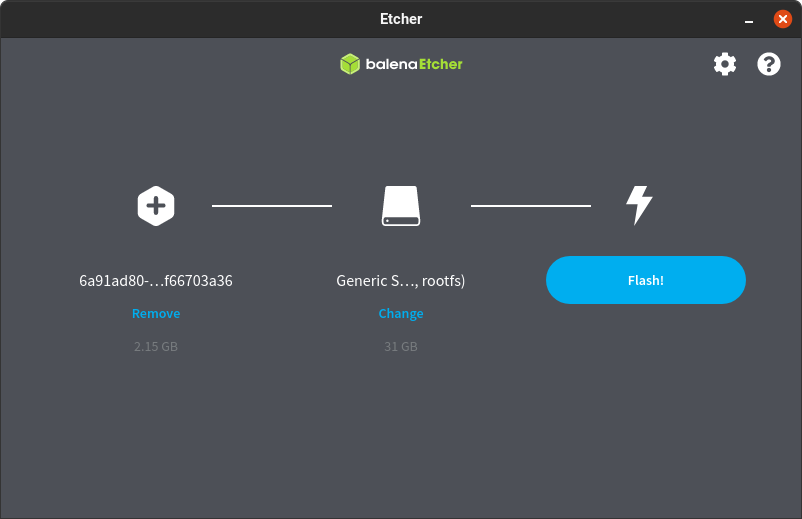- Generic x86-64
- Configure the BIOS on your x86-64 hardware
- Write the image to your boot medium
- Start up your Generic x86-64
- Install Home Assistant Container
- Platform installation
- Restart Home Assistant
- Docker compose
- Exposing devices
- Optimizations
- Install Home Assistant Core
- Install dependencies
- Create an account
- Create the virtual environment
Generic x86-64
Follow this guide if you want to get started with Home Assistant easily or if you have little to no Linux experience.
This guide assumes that you have a dedicated Generic x86-64 PC (typically an Intel or AMD-based system) available to exclusively run Home Assistant Operating System. The system must be 64-bit capable and able to boot using UEFI. Pretty much all systems produced in the last 10 years support the UEFI boot mode.
You will need to configure your Generic x86-64 PC to use UEFI boot mode, then write the HAOS (Home Assistant OS) disk image to your boot medium. There are two ways to do this listed below.
Configure the BIOS on your x86-64 hardware
To boot Home Assistant OS, the BIOS needs to have UEFI boot mode enabled and Secure Boot disabled. The following screenshots are from a 7th generation Intel NUC system. The BIOS menu will likely look different on your system. However, the options should still be present and named similarly.
- To enter the BIOS, start up your x86-64 hardware and repeatedly press the F2 key (on some systems this might be Del , F1 or F10 ).
- Make sure the UEFI Boot mode is enabled.
- Disable Secure Boot.
- Save your changes and exit.
The BIOS configuration is now complete.
Next, we need to write the Home Assistant Operating System image to the “boot medium”, which is the medium your x86-64 hardware will boot from when it is running Home Assistant.
HAOS has no integrated installer that writes the image automatically, you must write it manually using e.g. Etcher.
Typically an internal medium like S-ATA hard disk, S-ATA SSD, M.2 SSD, or a non-removable eMMC is used for the x86-64 boot medium. Alternatively, an external medium can be used such as a USB SDD, though this is not recommended.
To write the HAOS image to the boot medium on your x86-64 hardware, there are 2 different methods:
- Write the HAOS disk image from your desktop computer directly to the boot medium (e.g. using a USB to S-ATA adapter). If you can use this method, proceed to “Write the image to your boot medium” and follow all steps. If you have non-removable internal mediums or don’t have the necessary adapter, try the next method instead.
- Create a “live operating system” on a USB device running e.g. Ubuntu (how-to guide). Insert it into your system and boot the live operating system. Then follow from step 2 in “Write the image to your boot medium”.
When installing Etcher on Ubuntu you may need to install the fuse dependency first, to do this run the following commands in the terminal:
sudo add-apt-repository universe sudo apt update sudo apt install libfuse2 Write the image to your boot medium
- Attach the Home Assistant boot medium (storage device) to your computer.
- Download and start Balena Etcher. You may need to run it with administrator privileges on Windows.
- Select Flash from URL.
- Copy the URL for the image. If there are multiple links below, make sure to select the correct link for your version of Generic x86-64:
https://github.com/home-assistant/operating-system/releases/download/10.3/haos_generic-x86-64-10.3.img.xz Select and copy the URL or use the “copy” button that appear when you hover it.
- Paste the URL for the Generic x86-64 image into Balena Etcher and select OK.
- When Balena Etcher has downloaded the image, click Select target. Screenshot of the Etcher software showing the select target button highlighted.
- Select the boot medium (storage device) you want to use for your installation.
- Select Flash! to start writing the image.
- When Balena Etcher has finished writing the image, you will see a confirmation.
- If you are having issues with Balena Etcher, try version 1.10.
Start up your Generic x86-64
- If you used your desktop system to write the HAOS image directly to a boot medium like an S-ATA SSD, connect this back to your Generic x86-64 system.
- If you used a live operating system (e.g. Ubuntu), shut it down and remove the live operating system USB device.
- Plug in an Ethernet cable that is connected to the network.
- Power the system on. If you have a screen connected to the Generic x86-64 system, after a minute or so the Home Assistant welcome banner will appear in the console.
If the machine complains about not being able to find a bootable medium, you might need to specify the EFI entry in your BIOS. This can be accomplished either by using a live operating system (e.g. Ubuntu) and running the following command (replace with the appropriate drive name assigned by Linux, typically this will be sda or nvme0n1 on NVMe SSDs):
efibootmgr --create --disk /dev/ --part 1 --label "HAOS" \ --loader '\EFI\BOOT\bootx64.efi' The efibootmgr command will only work if you booted the live operating system in UEFI mode, so be sure to boot from your USB flash drive in this mode. Depending on your privileges on the prompt, you may need to run efibootmgr using sudo.
Or else, the BIOS might provide you with a tool to add boot options, there you can specify the path to the EFI file:
- In the browser of your desktop system, within a few minutes you will be able to reach your new Home Assistant at homeassistant.local:8123.
If you are running an older Windows version or have a stricter network configuration, you might need to access Home Assistant at homeassistant:8123 or `http://X.X.X.X:8123` (replace X.X.X.X with your Generic x86-64’s IP address).
With the Home Assistant Operating System installed and accessible, you can continue with onboarding.
Install Home Assistant Container
These below instructions are for an installation of Home Assistant Container running in your own container environment, which you manage yourself. Any OCI compatible runtime can be used, however this guide will focus on installing it with Docker.
This guide assumes that you already have an operating system setup and a container runtime installed (like Docker).
If you are using Docker then you need to be on at least version 19.03.9, ideally an even higher version, and libseccomp 2.4.2 or newer.
Platform installation
Installation with Docker is straightforward. Adjust the following command so that:
- /PATH_TO_YOUR_CONFIG points at the folder where you want to store your configuration and run it.
- MY_TIME_ZONE is a tz database name, like TZ=America/Los_Angeles .
docker run -d \ --name homeassistant \ --privileged \ --restart=unless-stopped \ -e TZ=MY_TIME_ZONE \ -v /PATH_TO_YOUR_CONFIG:/config \ --network=host \ ghcr.io/home-assistant/home-assistant:stable # if this returns "Image is up to date" then you can stop here docker pull ghcr.io/home-assistant/home-assistant:stable # stop the running container docker stop homeassistant # remove it from Docker's list of containers docker rm homeassistant # finally, start a new one docker run -d \ --name homeassistant \ --restart=unless-stopped \ --privileged \ -e TZ=MY_TIME_ZONE \ -v /PATH_TO_YOUR_CONFIG:/config \ --network=host \ ghcr.io/home-assistant/home-assistant:stable Once the Home Assistant Container is running Home Assistant should be accessible using http://:8123 (replace with the hostname or IP of the system). You can continue with onboarding.
Restart Home Assistant
- In your Home Assistant UI, go to the Settings >System and click the Restart button.
- You can go to the Developer Tools >Services, select the service homeassistant.restart and select Call Service.
- Restart it from a terminal.
docker restart homeassistant Docker compose
docker compose should already be installed on your system. If not, you can manually install it.
As the Docker command becomes more complex, switching to docker compose can be preferable and support automatically restarting on failure or system restart. Create a compose.yml file:
version: '3' services: homeassistant: container_name: homeassistant image: "ghcr.io/home-assistant/home-assistant:stable" volumes: - /PATH_TO_YOUR_CONFIG:/config - /etc/localtime:/etc/localtime:ro restart: unless-stopped privileged: true network_mode: host Once the Home Assistant Container is running, Home Assistant should be accessible using http://:8123 (replace with the hostname or IP of the system). You can continue with onboarding.
Exposing devices
In order to use Zigbee or other integrations that require access to devices, you need to map the appropriate device into the container. Ensure the user that is running the container has the correct privileges to access the /dev/tty* file, then add the device mapping to your container instructions:
docker run . --device /dev/ttyUSB0:/dev/ttyUSB0 . version: '3' services: homeassistant: . devices: - /dev/ttyUSB0:/dev/ttyUSB0 Optimizations
The Home Assistant Container is using an alternative memory allocation library jemalloc for better memory management and Python runtime speedup.
As jemalloc can cause issues on certain hardware, it can be disabled by passing the environment variable DISABLE_JEMALLOC with any value, for example:
docker run . -e "DISABLE_JEMALLOC=true" . version: '3' services: homeassistant: . environment: - DISABLE_JEMALLOC: true The error message : Unsupported system page size is one known indicator.
Install Home Assistant Core
This is an advanced installation process, and some steps might differ on your system. Considering the nature of this installation type, we assume you can handle subtle differences between this document and the system configuration you are using. When in doubt, please consider one of the other installation methods, as they might be a better fit instead.
This guide assumes that you already have an operating system setup and have installed Python 3.10 (including the package python3-dev ) or newer.
Install dependencies
Before you start, make sure your system is fully updated, all packages in this guide are installed with apt , if your OS does not have that, look for alternatives.
sudo apt-get update sudo apt-get upgrade -y sudo apt-get install -y python3 python3-dev python3-venv python3-pip bluez libffi-dev libssl-dev libjpeg-dev zlib1g-dev autoconf build-essential libopenjp2-7 libtiff5 libturbojpeg0-dev tzdata ffmpeg liblapack3 liblapack-dev libatlas-base-dev The above-listed dependencies might differ or missing, depending on your system or personal use of Home Assistant.
Create an account
Add an account for Home Assistant Core called homeassistant . Since this account is only for running Home Assistant Core the extra arguments of -rm is added to create a system account and create a home directory. The arguments -G dialout,gpio,i2c adds the user to the dialout , gpio and the i2c group. The first is required for using Z-Wave and Zigbee controllers, while the second is required to communicate with GPIO.
sudo useradd -rm homeassistant -G dialout,gpio,i2c Create the virtual environment
First we will create a directory for the installation of Home Assistant Core and change the owner to the homeassistant account.
sudo mkdir /srv/homeassistant sudo chown homeassistant:homeassistant /srv/homeassistant Next up is to create and change to a virtual environment for Home Assistant Core. This will be done as the homeassistant account.
sudo -u homeassistant -H -s cd /srv/homeassistant python3 -m venv . source bin/activate Once you have activated the virtual environment (notice the prompt change to (homeassistant) [email protected]:/srv/homeassistant $ ) you will need to run the following command to install a required Python package.
python3 -m pip install wheel Once you have installed the required Python package, it is now time to install Home Assistant Core!
pip3 install homeassistant==2023.7.2 Start Home Assistant Core for the first time. This will complete the installation for you, automatically creating the .homeassistant configuration directory in the /home/homeassistant directory, and installing any basic dependencies.
You can now reach your installation via the web interface on http://homeassistant.local:8123 .
If this address doesn’t work you may also try http://localhost:8123 or http://X.X.X.X:8123 (replace X.X.X.X with your machines’ IP address).
When you run the hass command for the first time, it will download, install and cache the necessary libraries/dependencies. This procedure may take anywhere between 5 to 10 minutes. During that time, you may get a site cannot be reached error when accessing the web interface. This will only happen the first time. Subsequent restarts will be much faster.







